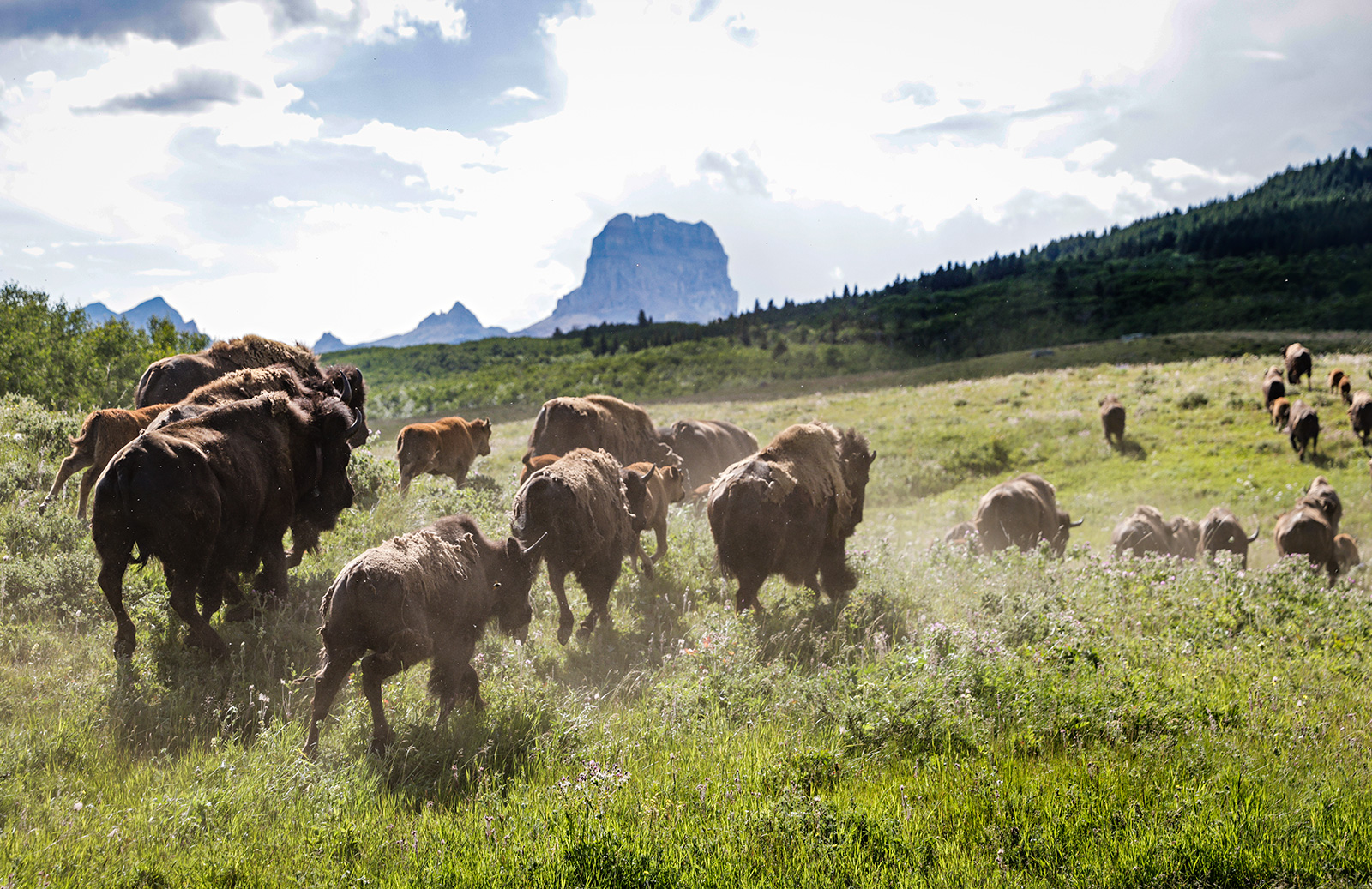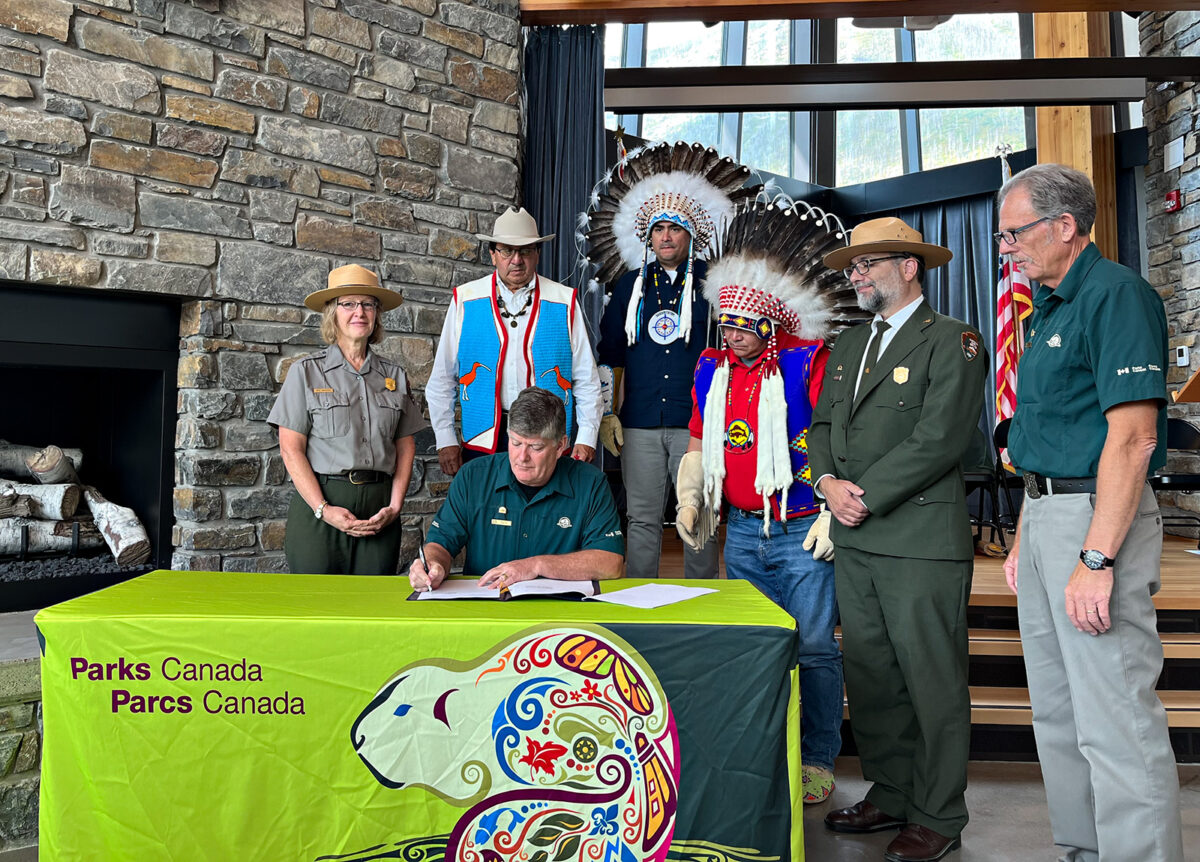
Glacier National Park Secures $1.5M to Support Blackfeet Bison Rewilding
An additional $470,514 in federal funding will allow Glacier to inventory cultural resources, promote ecosystem restoration and develop climate resilience projects
Last summer, Glacier National Park leaders stood beside their Indigenous neighbors in solidarity as the Blackfeet Nation released a herd of wild bison into the rolling foothills at the base of Chief Mountain, on tribal land just beyond Glacier’s boundary. Park administrators celebrated the historic rewilding of traditional Blackfeet territory as an inflection point in co-stewardship, understanding that the buffalo would almost certainly wander across the park’s border, or perhaps even cross into Canada.
Two months later, representatives from the National Park Service (NPS) and Parks Canada joined Indigenous leaders at Waterton-Glacier International Peace Park to renew a longstanding transboundary relationship and to prioritize the co-management of public lands between the federal agencies and the tribes, including the Blackfoot Confederacy, Salish, Pend d’Oreille, and Kootenai tribes.
Still, even as federal land managers on both sides of the international border reaffirmed a commitment to tribal co-stewardship of their shared resources, it remained unclear how that support would materialize.
On Monday evening, that question was answered when Glacier National Park officials announced securing more than $1.9 million in funding from the Inflation Reduction Act (IRA) to continue work on advancing bison reintroduction, as well as to inventory cultural resources impacted by climate change and protect and restore whitebark pine. Federal land managers characterized the financial commitment as “a promise to future generations.”
Approximately $1.5 million of the IRA funding will help assist the Blackfeet in their bison initiative by coordinating landscape-level studies on ecosystem function and connectivity, including research to gain a better understanding of whether deer and elk forage differently with the presence of bison on the landscape. “NPS is also assessing infrastructure needs and placement to support visitor use, enjoyment and safety,” according to the press release announcing the funding.
“Glacier National Park continues to actively support the Blackfeet-led vision to establish a free-ranging bison herd in northwest Montana,” the announcement states. “The herd is expected to roam freely onto NPS lands.”
On the Blackfeet Indian Reservation, efforts to restore free-roaming bison to the landscape have been gaining momentum for years as tribal leaders and wildlife managers increasingly recognize not only their ecological significance to a landscape that, in their absence, has been transformed, but also their central role to the tribe’s cultural lifeways.
Known as the Iinnii Initiative and launched in 2009, the leaders of the Blackfoot Confederacy have been working to conserve traditional lands, protect Blackfeet culture and ensure bison have a home. In 2014, the four nations within the Blackfoot Confederacy — the Blackfeet Nation, the Kainai Nation, the Piikani Nation and the Siksika Nation — held a Tribal Treaty Convention, committing the northern Tribes and First Nations to promote their cultural practices and land protections through the repatriation of buffalo.
In 2016, those efforts took a leap forward with the arrival of 88 young bison from Elk Island National Park in Alberta, Canada, where direct descendants of the Blackfeet’s last wild herd, captured in 1873 by Samuel Walking Coyote, have lived for a century-and-a-half, forming the core of a herd tribal officials hoped would one day roam freely on their native land. Last summer, the Blackfeet Tribal Business Council passed a resolution calling for the release of 20 mature buffalo (five mature bulls and 15 mature cows) and five calves into the Chief Mountain area, as well as the drafting of a memorandum of understanding with Glacier National Park leadership. The herd was released on June 26, 2023.

Glacier was also awarded $200,514 as part of a multi-park project to inventory cultural resources in the Intermountain West’s high-elevation areas impacted by climate change. Other parks awarded additional funding include Yellowstone and Grand Teton.
“More than 11,000 years of human occupation and Native American cultural heritage have been documented in Glacier National Park,” according to the park’s announcement. “These resources are experiencing loss through climate change driven impacts such as wildfire and melting ice.”
NPS plans to target the most critically affected and threatened non-renewable cultural resources, including artifacts and organic materials left behind as glaciers melt, as well as eroded river banks impacting ancient campsites. The study will also identify climate signals, such as the frequency of wildland fires and changing weather patterns, to determine their impacts to cultural resources within high-alpine landscapes and stable (non-moving) ice patches.
Finally, Glacier received $270,000 to restore threatened whitebark pine and implement the National Whitebark Pine Restoration Strategy. This is also a multi-park project that includes additional funding awarded to Yosemite, Sequoia, Kings Canyon, Olympic, Mount Rainer, North Cascades, Grand Teton, and Yellowstone national parks, totaling $750,000. The project includes working with partners and tribes to plant blister rust resistant seed and seedlings, identify rust resistant trees, monitor seedling survival, and identify climate refugia. The project builds on 20 years of work at Glacier National Park and within the Greater Yellowstone Ecosystem.

Glacier National Park’s climate related projects are part of an overall $195 million investment from the IRA announced last week to prepare parks across the country to be resilient to climate change.
“These investments are incredibly timely, as healthy ecosystems, wildlife and native plant habitats, and cultural resources are threatened by climate change and many other environmental challenges,” the press release states.
“Glacier is on a lot of people’s minds when thinking about the impacts of a changing climate,” Glacier National Park Superintendent Dave Roemer said in a prepared statement. “These projects will help us prepare, restore, and preserve key aspects of the park that make Glacier special. What ties these efforts together is the development and use of high-quality information to inform management, and the coordination of these efforts with the Blackfeet Nation and the Confederated Salish and Kootenai Tribes.”

In the funding announcement, federal land managers characterized the financial commitment as “a promise to future generations.”
“Through the Inflation Reduction Act, the National Park Service is working to address the impacts of the climate crisis, including intensifying drought, wildfires, flooding and legacy pollution in national parks and other public lands,” the release states. “These resources will serve parks and communities across the United States with forward looking impact.”
Through the Bipartisan Infrastructure Law and the Inflation Reduction Act, the Department of the Interior is implementing more than $2 billion in overall investments to restore the nation’s lands and waters. As climate change becomes an overarching influence transforming NPS units, the funding will also advance the Interior Department’s initiative to restore and conserve 30% of lands and waters by 2030.
For additional information about IRA projects nationwide, visit the NPS’ IRA webpage.